
table of contents
- care
- Location
- plants
- to water
- Fertilize
- Cut
- Overwinter
- Multiply
- Diseases
Profile and care information open +conclude -
- Flower color
- yellow
- Location
- Partial shade, shady, sunny, full sun
- Heyday
- January, February, March, December
- Growth habit
- upright, spreading, bushy, perennial, climber, overhanging
- height
- up to 200 centimeters high
- Soil type
- sandy, loamy, gritty, clayey
- Soil moisture
- moderately dry, fresh
- PH value
- weakly acidic, alkaline
- Limescale tolerance
- Calcium tolerant
- humus
- rich in humus
- Poisonous
- no
- Plant families
- Olive family, Oleaceae
- Plant species
- Ornamental shrubs, container plants, climbing plants, rock garden plants
- Garden style
- Conservatory, ornamental garden, terrace garden, front garden, flower garden, park
The winter jasmine, botanically called Jasminum nudiflorum, is one of the special features among the flowering shrubs, because the yellow flowers appear on the wood at a time when not much color can otherwise be found in our gardens is. With a flowering time between December and March, the winter jasmine is a real winter bloomer, which with its numerous flowers adds bright yellow spots. In contrast to many other types of jasmine, winter jasmine is unfortunately not fragrant.
care
The yellow winter jasmine is one of the ornamental shrubs that are really easy to care for, especially if it has been planted in a suitable location. There the bush grows and thrives with almost no gardener doing anything.
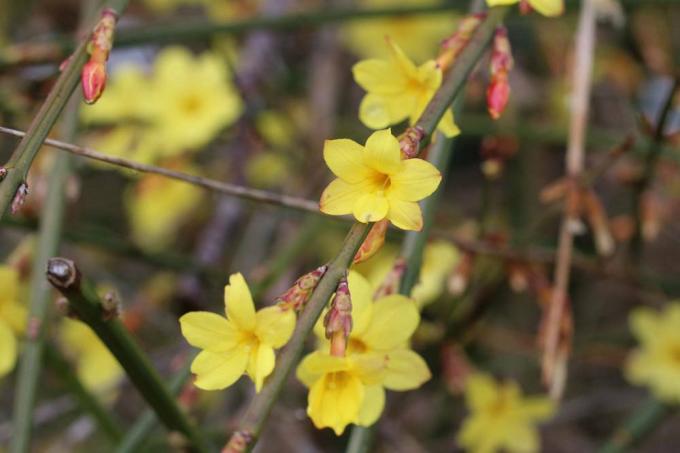
Location
When it comes to its location, the yellow blooming winter jasmine makes no great demands. It prefers a sunny to partially shaded place in the garden, where it is nice and warm. It should be a little sheltered from wind and severe frosts, for example on a wall or a wall ledge. As a solitary plant in the front garden, the shrub grows bushy with strongly overhanging branches that have a square cross-section. Because of its appearance, winter jasmine is often confused with forsythia or the yellow-flowered gorse. That is why it is also known as winter gorse.
- Light requirement: sunny to partially shaded
- sheltered from the wind
- protected from heavy rain
- as warm as possible
- the sunnier the location, the more abundant the flowering
With a little help, the naked-blooded jasmine is able to expand in all directions. Therefore it can also be used universally. Due to its slightly climbing habit, the ornamental shrub is ideal for greening house walls, terraces and fences or for concealing building sins. With a climbing aid, it can effortlessly reach heights of between three and five meters. As a hanging variant, it seems to flow down stairs or walls. And on top of that, it is also able to stabilize embankments and slopes and protect them from erosion.
floor
As far as the soil conditions are concerned, the naked-blooded jasmine is a real all-rounder. Apart from extreme conditions, the adaptable shrub grows on almost any garden soil. Regardless of whether it is sandy or slightly damp, slightly acidic or alkaline (calcareous), it adapts well everywhere. Only in the rarest of cases does the soil need to be improved. Very sandy garden soils need some humus-rich universal soil or compost in order to be able to store the water better.
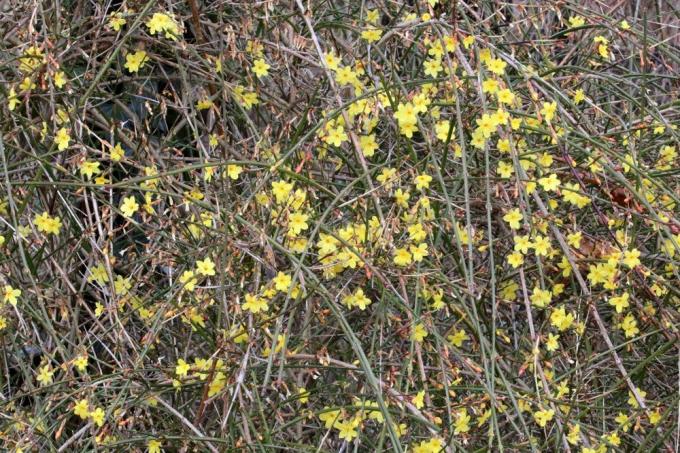
- sandy-loamy
- fresh to moist
- rich in humus and nutrients
- pH value: slightly acidic to alkaline (5.5 to 8)
- lime compatible
The substrate for potted plants should on the one hand be well permeable to water and on the other hand be able to store moisture. A mixture of humus garden soil, loam and sand is an ideal mixture for the winter jasmine. Alternatively, a high quality bucket substrate can also be used.
Climbing aid
The winter jasmine is - in terms of its growth form - a very changeable companion. It grows as an overhanging shrub, as a ground cover or as a climbing plant. If it is to grow in height, for example to green house walls or walls, it needs a climbing aid. The shoots of the shrub have no climbing organs such as tendrils or thorns with which they could hold on. The flowering shrub grows on trellises or a pergola only because of its flexible shoots. No additional climbing aid is required on open fences. However, the young shoots have to be guided into the scaffolding by hand and tied if necessary.
Potted plants
The easy-care winter jasmine also grows in a tub without any problems. If he is given a climbing aid, he can reach heights of up to two meters. Without such a support, it usually does not grow taller than a meter, as its flexible branches overhang in an arch. Choose a sufficiently large planter that offers enough space for the roots and has good stability.
- only use containers with drainage holes
- Size for young plants: at least 10 liters
- older plants require at least 40 liters
Right at the beginning, plant a planting stick or a climbing aid in the pot to guide the shoots upwards. Then place the plant next to a trellis so that the bush can expand further.
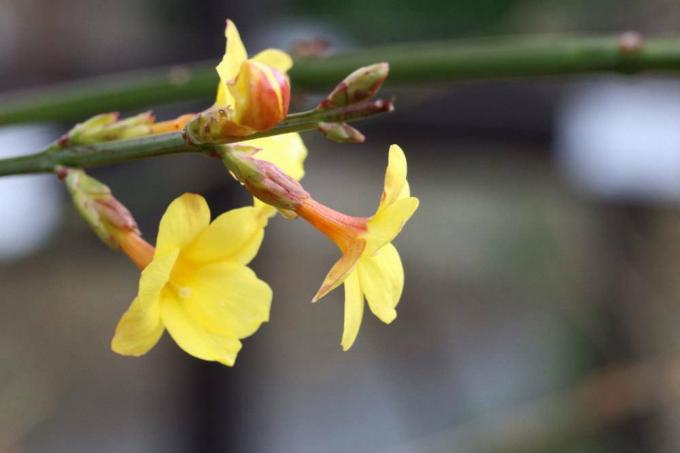
plants
There is not much to consider when planting the sturdy shrub. Just make sure that the soil around the planting hole is well loosened. This also applies to the depth. It is best to mix some ripe compost into the excavation to create the best conditions for healthy and vigorous growth right from the start. Before planting, you should put the winter jasmine in a bucket with water until no more air bubbles rise.
- Planting hole: double the ball depth and width
- Plant spacing: as a solitary shrub without climbing aid about 1 to 1.5 m
- Planting a little closer can be done with a climbing aid
- 1 m is sufficient for hedge plants
Often a dense network of roots has already formed on the outside in the narrow pots. Tear the braid lightly by hand so that the new roots can more easily spread in the soil.
Planting time
The best time to plant the ornamental wood is in spring. With a little luck, the shrub will bloom in the coming winter. Basically, it can of course also be planted in the garden in autumn, but then it usually takes a little over a year to flower for the first time.
to water
In normal weather conditions with occasional rain showers, the winter jasmine does not need any additional watering. However, the shrub does not tolerate long dry periods or particularly sandy soils. You should therefore water the plant regularly, especially in the warmer months, but avoid waterlogging.
Fertilize
Jasminum nudiflorum is quite robust and hardly needs any special attention. Fertilization is also not absolutely necessary. However, the plant is happy about a gift of compost or a handful of horn shavings in spring and possibly a little lime and thanks it with a lush abundance of flowers in the winter months. Container plants are best supplied with an organic or organic-mineral long-term fertilizer in spring.

Cut
The yellow winter jasmine grows slowly during the first few years. When grown in well, the shoots can easily gain 25 cm in growth per year. Therefore, the shrub should be pruned regularly as it gets older. The long shoots grow uncontrollably, often lying flat on the ground. Winter jasmine has the ability to grow new roots from drooping branches that touch the earth. A bush that has not been cut for years therefore tends to grow wild.
- Time: after flowering (April)
- Trim the flower stems by about a third
- Cut long twigs that lie on the ground
- Take out dead and diseased shoots
The winter jasmine only flowers on the annual shoots that formed on the plant in the previous year. If it is not cut back, more and more old wood will be produced and the once lush bush will only bloom timidly. The wood is very easy to cut. If you have taken too radical a step, the plant will recover relatively quickly. Bushes that have been neglected for years and therefore no longer bloom or are rather out of shape can easily be radically cut back to about 60 cm. After a short time, the bare-bloomed jasmine sprouts bushier than ever and often begins to bloom again in the following year.
Overwinter
The shrub from China is not only frost hardy, it also flowers in the middle of winter. Jasminum nudiflorum is one of the few frost-resistant winter bloomers. In mild weather, it opens its yellow flowers, which are a little reminiscent of forsythia, before Christmas. The winter jasmine is hardy in our latitudes, but the pretty flowers suffer in strong frosts. While the buds can withstand temperatures of -15 degrees, the open calyxes are a bit more sensitive. But even if the flowers die, you don't have to do without the splashes of color entirely. When the temperatures get warmer again, the remaining buds open.
Well-established plants do not need additional protection against the cold outdoors. But it doesn't hurt to put a thick layer of mulch, straw, or leaves on the ground. Shrubs that are grown in a bucket should be provided with winter protection in autumn so that the root ball does not freeze through during frosts.

- Protect young plants from cold winds with fir twigs
- Place the pot on a thick styrofoam plate
- wrap with a mat, fleece or bubble wrap
- Cover the root ball with straw or leaves
A very pleasant property of winter gorse, which is rather unusual for shrubs, is that the younger wood does not remain brownish, but rather a fresh green color. In autumn the shrub sheds its leaves and the flowers develop on the "bare" shoots. Since the branches themselves are also green, the shrub looks like it is evergreen.
Toxicity
In general, the deciduous winter jasmine is considered non-toxic. Since the plant also has no thorns, the joy of a household with children remains undimmed. Only the egg-shaped berries contain incompatible substances in low concentrations. The berries don't taste particularly good, however, so the risk is very low.
Multiply
There are a few ways to propagate winter jasmine. Propagation from seeds works, but is of little importance in practice.
Sinker
The simplest method is to multiply by subscribers. The strongly overhanging shoots of winter jasmine have the ability to form new roots when they come into contact with the ground. So it can be that the bush multiplies all by itself. Especially if it is not cut back regularly. In this case, you can cut off the sinker with a sharp spade if it has already formed roots. For climbing specimens, simply direct a long shoot into the ground.
- Time: possible all year round
- excavate an elongated recess
- Depth: about 10 to 15 cm
- Introduce instinct
- Guide the shoot tip upwards on the other side
- initially not vertically, but at an angle of 45 degrees
- for example tie to a stick
- Cover the middle section lying in the ground with earth and step well
- wait a couple of months
- cut with a spade after the roots have formed
- cultivate elsewhere
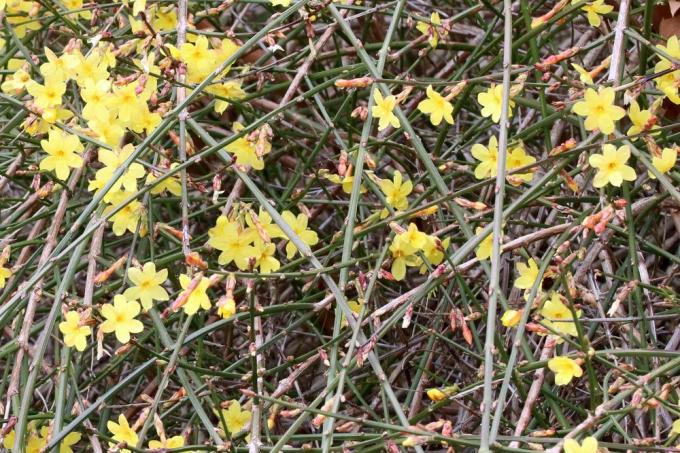
If the shoot does not hold in the ground by itself, you can weigh it down with a stone or fix it with two U-shaped brackets. The shoot should look out at least 15 to 20 cm on the other side so that it can be easily tied up. If it is too short, it is best to let it grow for another season. Otherwise there is a risk that the drive will break off when it is diverted.
Cuttings
Propagating cuttings from naked-flowered winter jasmine is also very easy. To do this, cut a fresh shoot tip in early summer and stick it in moist soil.
- Time: early summer
- Cut the shoot tip 10 to 15 cm long
- remove all lower leaves
- Slightly scrape off the bark at the bottom 2 cm
- stuck in substrate
- Depth: 3 to 5 cm
- Substrate: potting soil or a mixture of potting soil and sand
- Put the freezer bag over the pot
- fix at the bottom with a tape or elastic
- set up brightly, avoid direct sun
- Temperature: 15 to 20 degrees
- keep slightly moist
If the cutting begins to grow or to form new leaves, this is a sure sign that it has developed roots in the meantime. Remove the plastic bag and continue cultivating the young plant like normal shrubs. Do not plant the cutting in the field until the temperatures allow it. If the cuttings take root before September, they can be planted in the garden before winter. All cuttings that are later to take root or are to be cultivated in pots should stay in a sheltered house or in a frost-free place in the garage or basement until spring.
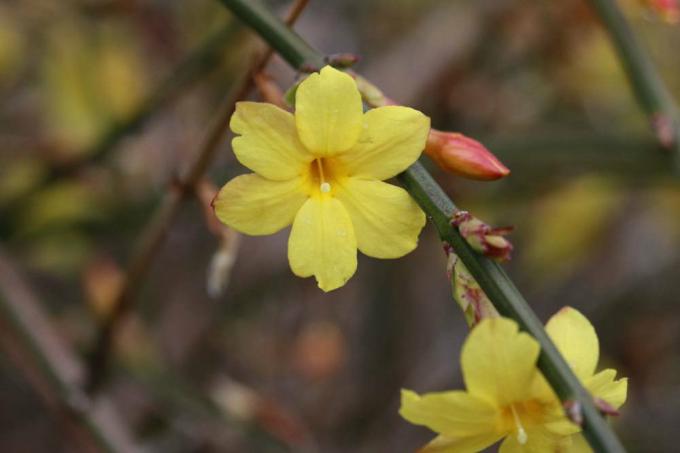
Diseases
In the right location, the winter jasmine is almost indestructible and is only very rarely afflicted by diseases and pests. However, powdery mildew can occasionally occur in unfavorable weather conditions. As a rule, however, it does not cause lasting damage to the shrub.
Aphids
Aphids can also occasionally cause problems. Depending on the weather, they multiply the pests like an epidemic and then suck out the sap in large numbers. They are not very particular about the type of plant. Most of the time, the animals sit on the tips of the shoots or on the underside of the leaves, where they are difficult to recognize. If the infestation is not very advanced, home remedies such as nettle manure or a mixture of soapy water and alcohol can help. There is also the possibility of using parasitic wasps against aphids. In the case of extreme infestation, the only way to stop the plague is often pesticides.



